Key takeaways:
- Quantitative easing (QE) lowers interest rates, encourages lending, and can lead to both asset price increases and concerns about its long-term economic sustainability.
- QE significantly influences investment strategies, shifting focus from safer assets to riskier securities, while fostering a mindset that prioritizes short-term gains over long-term planning.
- The future outlook for QE remains uncertain, with potential market volatility and inflation concerns as central banks may eventually taper their policies.
- Adjusting investment portfolios in response to QE requires a recalibration of expectations and a diversification strategy that aligns with individual risk tolerance.

Understanding quantitative easing effects
Quantitative easing (QE) has a profound impact on the economy, primarily by lowering interest rates and encouraging lending. I still remember the sense of relief I felt when central banks announced QE during economic uncertainty; it felt like a safety net for individuals and businesses alike. However, I often wonder about the long-term effects—will these actions lead to more robust growth or simply act as a temporary bandage on deeper economic wounds?
When the Federal Reserve or other central banks engage in QE, they essentially inject liquidity into the financial system, which can drive up asset prices. I’ve seen this firsthand; clients who were initially skeptical about the stock market began to invest as they noticed their peers capitalizing on these rising valuations. Doesn’t it make you question the sustainability of gains that are primarily based on monetary policy rather than fundamental growth?
Another interesting facet of QE is its effect on inflation. Initially, many feared that flooding the market with money would lead to runaway inflation, yet we’ve often seen the opposite scenario unfold. Personally, I felt a mix of confusion and curiosity as I watched deflationary pressures persist even after extensive QE measures. How do we reconcile the expectation of inflation with the reality? It’s a fascinating puzzle that continues to challenge economic thinkers and investors alike.
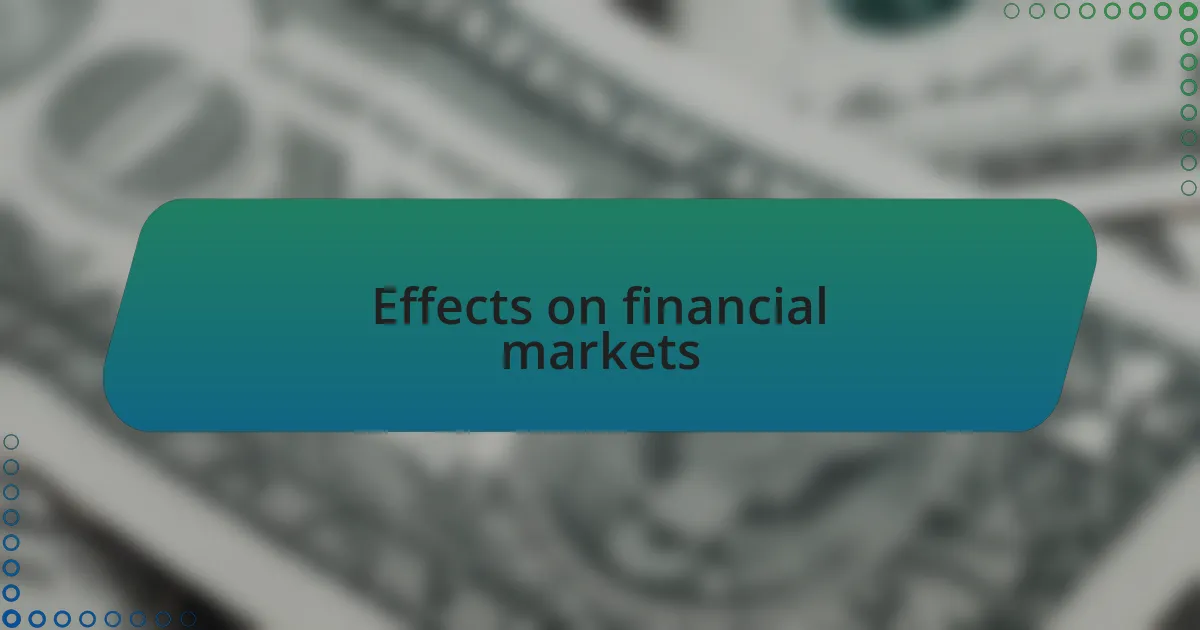
Effects on financial markets
When central banks implement quantitative easing, I often see a clear ripple effect across financial markets. For instance, bond prices tend to rise due to the increased demand created by low-interest rates, which can lead to tighter spreads that investors initially perceive as a stable investment. However, I can’t help but wonder if this ultimately creates an illusion of security that might crumble under economic pressure.
I remember discussing with clients how QE often shifts investor focus from traditional, safer assets to riskier securities like stocks. It’s almost intoxicating to watch the market surge, but the underlying anxiety remains. Could the surge in stock prices indicate genuine economic recovery, or are we simply riding an artificial wave fueled by relentless monetary support?
Furthermore, I’ve encountered situations where the effects of QE lead to market volatility as expectations shift. One day, a positive jobs report might lift spirits, while the next could bring fears of tapering. It makes me reflect: are we truly investing based on robust fundamentals, or are we just reacting to the whims of monetary policy? The uncertainty can be both exhilarating and daunting, challenging our long-held beliefs about investment strategy.

Impact on interest rates
When central banks embark on quantitative easing, I often note how it significantly impacts interest rates. It feels almost paradoxical; as they increase the money supply, rates tend to fall. This makes borrowing cheaper, which can be a boon for investors and businesses alike, yet I can’t shake the concern about the long-term implications. Are we paving the way for a future where higher inflation might rear its head due to this very strategy?
One moment that stands out to me was when rates dipped to historic lows after a round of QE. Clients were eager to seize the opportunity, seeing it as a golden chance to refinance or invest in new projects. However, there was an undercurrent of anxiety—a fear that these low rates wouldn’t last forever. How many of us truly understand that even as we celebrate lower borrowing costs, we’re also taking on the risk of future hikes? That tension between present opportunities and future uncertainties is something I see playing out repeatedly.
Moreover, I have seen the reaction to interest rate changes be almost immediate and visceral among investors. I remember a particularly charged discussion where news of a potential interest rate rise sent panic through the room. It struck me how intertwined our investment strategies are with the fluctuations of monetary policy. Are we navigating our financial futures, or are we at the mercy of these unpredictable shifts? It’s a question that lingers in my mind as I guide clients through their financial journeys.
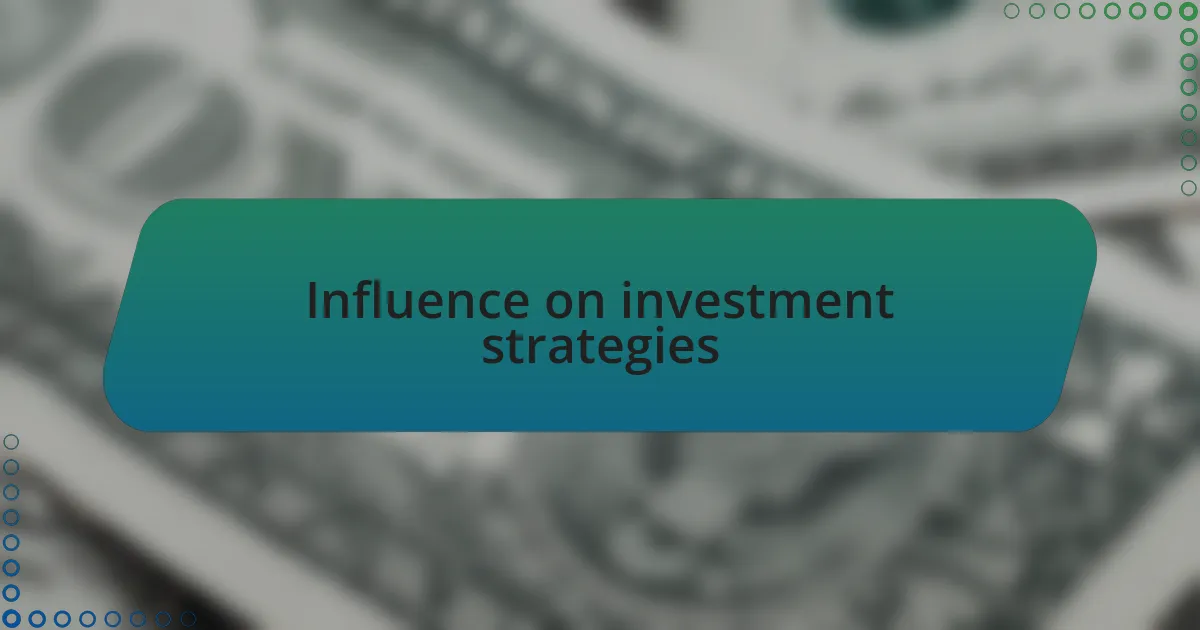
Influence on investment strategies
When it comes to investment strategies, I find that quantitative easing often shifts the landscape dramatically. For instance, I recall advising a client during a period of aggressive QE. They were initially hesitant but soon began to see the immense potential in equities, particularly in sectors that thrive on low borrowing costs. How fascinating is it that a central bank’s policy can reshape one’s entire investment portfolio?
Moreover, I’ve witnessed how the influx of liquidity encourages a chase for yield, sometimes leading investors into riskier assets. I remember discussing with a colleague the surge in interest towards high-yield bonds. It was a lively debate—while seeking greater returns can be enticing, what about the underlying risks? This balance between potential rewards and the need for caution is a tightrope walk many investors must navigate.
I also believe that the effects of QE extend beyond just immediate returns. For example, I’ve noticed how many clients, after experiencing the era of low rates, have developed a mindset focused on short-term gains, often overlooking the importance of long-term strategies. In our discussions, I frequently ask: are we becoming too myopic due to the allure of easy money? This reflection is essential as we forge our diverse investment paths.
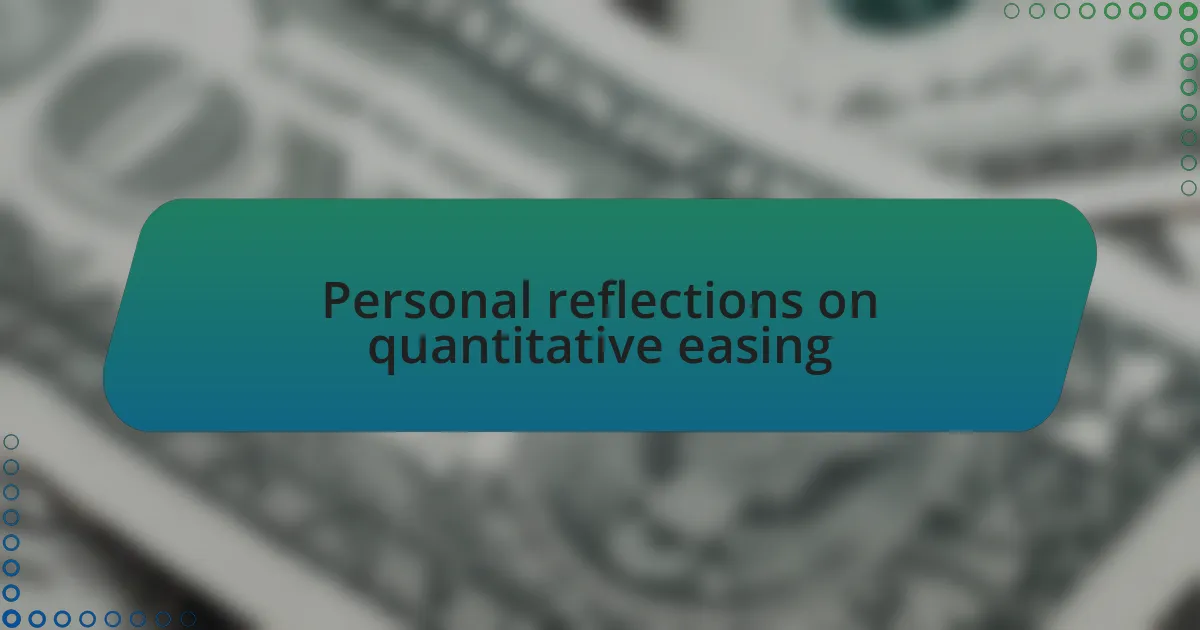
Personal reflections on quantitative easing
It’s intriguing how quantitative easing has shaped my perspective on market dynamics. I recall attending a seminar where the speaker emphasized the impact of central bank policies on investor behavior. That day, I realized that QE not only fuels market growth but also influences the very psychology behind our investment decisions. Isn’t it remarkable how a policy change can shift the overall sentiment, making us rethink our strategies?
In my practice, I’ve felt a palpable tension between optimism and caution stemming from QE. During a client meeting, one individual expressed excitement about potential returns, yet I sensed an underlying fear of market volatility. It struck me how deeply these monetary policies can instill a dual-edged nature in our discussions—excitement about prospects, tempered by the anxiety of unpredictability. How do we find harmony between these competing feelings in our investment choices?
Reflecting on my experiences, I’ve often confronted a dilemma: should we embrace the low-interest environment or remain wary of its consequences? When talking with fellow investors, I’ve uncovered a shared unease about becoming overly reliant on easy credit. It’s this conversation—filled with earnest concerns and aspirations—that fuels my belief in maintaining a balanced viewpoint amidst the allure of quick gains. How can we harness the opportunities of QE while ensuring our long-term financial stability remains intact?
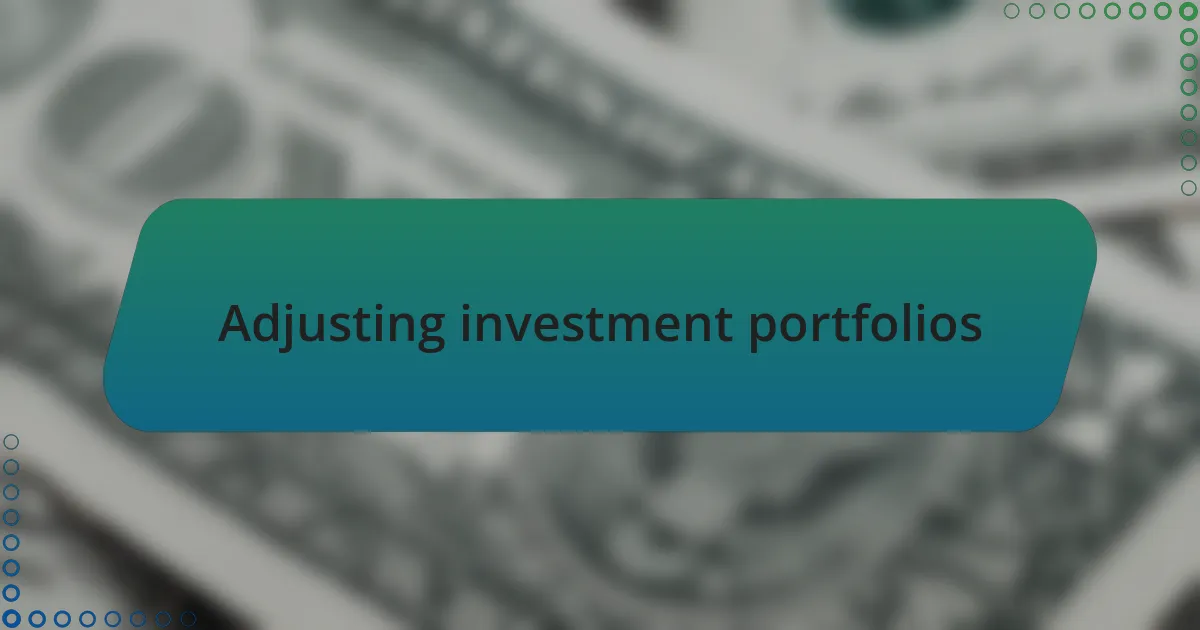
Adjusting investment portfolios
Adjusting investment portfolios in response to quantitative easing is not just about shifting numbers; it’s about recalibrating our expectations. I remember reviewing a client’s portfolio who was heavily invested in bonds, driven by the low-interest rates that QE created. As I explained how this could potentially affect his yield, I could see the realization wash over him—it was time for a more diversified approach.
I find that many investors often overlook the importance of adapting their strategies amidst changing market policies. During a recent consultation, I met a couple who felt stuck in their conservative investments out of fear. I gently suggested exploring equities, especially in sectors benefiting from increased liquidity, and their faces lit up with hope. Isn’t it fascinating how a slight shift in mindset can unlock new opportunities?
When I make portfolio adjustments, I always consider an investor’s individual risk tolerance alongside market shifts. For instance, while discussing with a young professional eager for growth, I emphasized the need to prioritize growth stocks, given the potential long-term effects of QE on the market. We navigated through various strategies, and I could feel her excitement build—it’s a reminder that our investment journeys can thrive with the right adjustments.
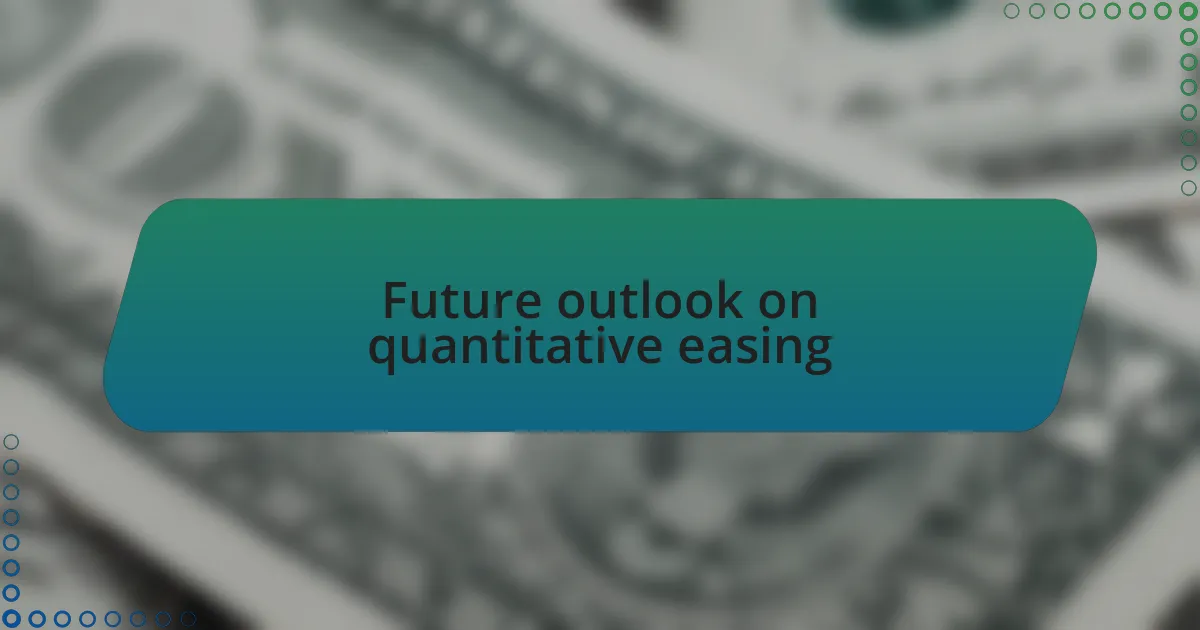
Future outlook on quantitative easing
The future outlook on quantitative easing (QE) is complex and teeters on a delicate balance. I remember an intense discussion with a fellow investment consultant about what would happen once the central banks shift their focus away from QE. We both agreed that a premature withdrawal could lead to significant market volatility, sparking a flurry of investor anxiety. How might we prepare our strategies for such an unpredictable environment?
As we look ahead, I can’t help but think about the long-term effects of QE on inflation and interest rates. A while back, I analyzed a scenario where sustained QE led to rising asset prices but left many investors wondering about the lasting value of their investments. It’s a vital question: are we truly creating wealth, or are we just inflating bubbles? The realization dawned on me—investors must stay vigilant and adjust their expectations to avoid being caught off guard.
Considering the societal implications of QE offers another layer of insight. I recall a conversation I had with an old mentor who emphasized that the real economy doesn’t always reflect asset price movements influenced by QE. He urged me to consider the broad picture, including how these policies affect job growth and consumer spending. How can we, as investment consultants, ensure our clients are aware of these dynamics? By fostering a deeper understanding of the mechanisms at play, we empower our clients to make informed decisions, preparing them for the eventual outcomes of our current monetary policies.